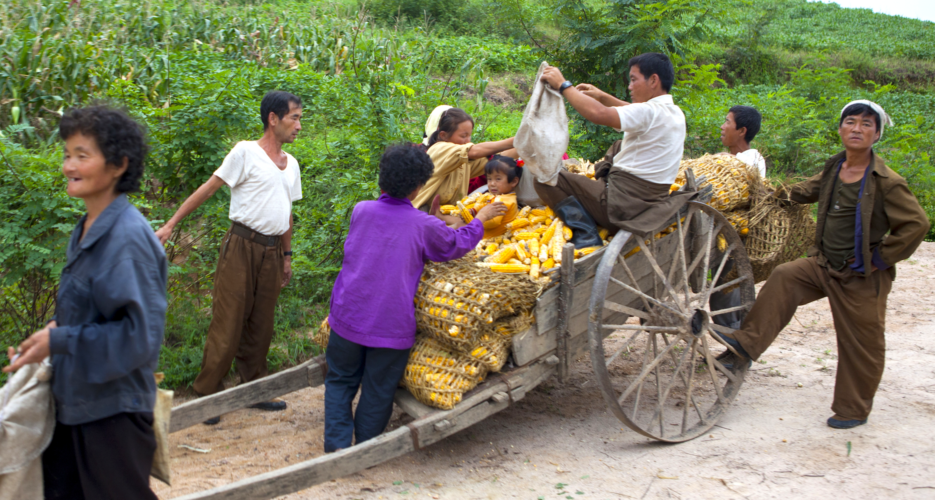North Korea’s got 99 problems and rural development is one
2022 focus on agriculture reflects both growing food insecurity and Maoist-inspired efforts to improve countryside life
Benjamin R. Young February 4, 2022

Image: Eric Lafforgue (Sept. 7, 2012) | North Korean farmers collecting corn on a cart in North Hwanghae province
At a recent plenum of the Eighth Central Committee, Kim Jong Un pointed out the “rural problem” in North Korean society. With the pandemic and sanctions, the North is more isolated than it has ever been. The countryside has felt the brunt of these economic issues and falls further behind in development goals. As evidenced by recent North Korean media reports, ideological cohesion and Party discipline is also slipping in the provinces.
As a result, Kim Jong Un has rekindled Kim Il Sung’s reverence for the countryside and reprioritized “rural development” in 2022. Under the rubric of “socialist rural construction,” Kim Jong Un hopes to improve crop yields in farming communities and reform the agricultural sector. According to state-run media, Kim promised to “boost agricultural production to completely resolve the country’s food problems.”
Alongside these economic concerns, Kim Jong Un will also be tightening up the ideological discipline of the masses and instituting more political education concentrated on his new doctrine of “Kimjongunism.”
According to state media, mass organizations are already mandating the study of documents from the recent plenum. By doing so, the Korean Central News Agency (KCNA) explained, party apparatchiks will “prepare themselves as communists who strive for the prosperity and development of the country, guided by the Juche idea.”
State media did not directly link Kim Jong Un’s “rural development” agenda item to the 60th anniversary of Kim Il Sung’s rural theses speech, but foundational texts such as “Theses on the Socialist Rural Question in Our Country” occupy a central place in North Korean hagiography and are often commemorated as part of the leadership’s revolutionary heritage.
Thus, it is likely not coincidental that Kim Jong Un’s priority in 2022 is rural development. While food insecurity may be the immediate motivating concern, the DPRK has long sought to develop the countryside alongside urban areas, and this most recent campaign slots into a longstanding North Korean pattern of connecting the past to the present.
 A North Korean propaganda poster in South Pyogan province showing Kim Il Sung with farmers | Image: Eric Lafforgue (May 16, 2009)
A North Korean propaganda poster in South Pyogan province showing Kim Il Sung with farmers | Image: Eric Lafforgue (May 16, 2009)PEASANT AND PROLETARIAT
In the “Communist Manifesto,” Karl Marx referred to the “idiocy of rural life.” Simply put, the German theorist thought modern society needed to be centered on cities and urban areas. He looked upon the countryside and peasant culture with disdain. As a modernizing philosophy, Marxism privileged the city over the countryside.
Vladimir Lenin, the first national leader to install Marxism as state policy, reorganized a rural Russian society into an industrial urban one. Lenin sought to remake the feudal “peasant” into a modern “proletarian.”
It was only under Mao Zedong that the Communist project recognized the revolutionary zeal of the peasant masses. Mao emphasized the revolutionary potential of the peasantry and saw them as the vanguard of radical social change. In his bid to be the torchbearer of world revolution, Mao exported his theories on peasant-led revolution, which promoted collectivism, armed struggle and rural insurrection.
Taking a cue from his Chinese neighbor, North Korea’s founding leader Kim Il Sung emphasized rural revitalization and the patriotic spirit of peasants. In 1962 with local Party officials in Changson County, Kim Il Sung first laid out his “Theses on the Socialist Rural Question in Our Country.” This treatise became the organizing framework for the DPRK’s agricultural and environmental policies. It aimed to improve rural life and agricultural output.
As the son of a poor peasant family who grew up in colonial Korea, Kim acutely understood that the problems of rural impoverishment increased with oppressive colonial policies. In the thesis, Kim Il Sung points out, “The rural question acquires an especially important meaning in many countries formerly or still under the imperialist and colonialist yoke. In these countries, the successful solution of the peasant and agricultural questions is the key to the victory of the revolution and to social progress.”
However, as the founding leader of a Soviet client state, Kim Il Sung could not orient the North Korean revolution in a purely Maoist-style path. Amid the Sino-Soviet split of the Cold War, Pyongyang often tried to take a middle path on ideological matters. For example, during the Chollima Movement of the 1960s, North Korea’s leadership deployed Soviet-style Stakhanovism as a mobilizing force to increase industrial production.
With the advent of the Three Revolutions campaign in the 1970s, Kim Il Sung instituted Maoist-style revolutionary principles in the countryside and increased the Party’s ideological control over the masses. Kim Il Sung tried to steer the nascent North Korean state to be both urban and rural. Alongside a heavily Soviet-subsidized industrial base, the North Korean leadership hoped that farming communities would thrive and thus the revolutionary potential of peasants would be unleashed in order to fulfill the Korean Revolution.
However, with the exception of the showcase capital city, the reality of North Korean development is that both the cities and the countryside were in constant need of investment and economic support from the Party center.
Edited by Arius Derr
No comments:
Post a Comment